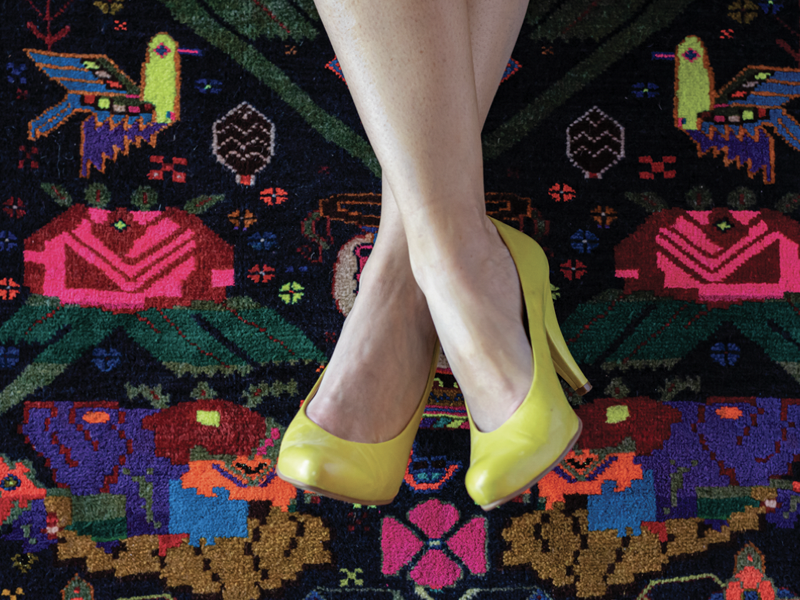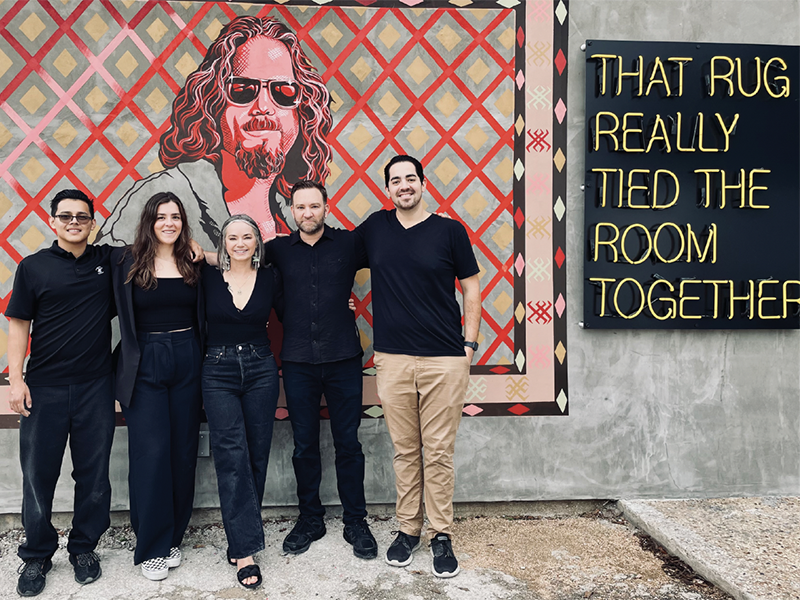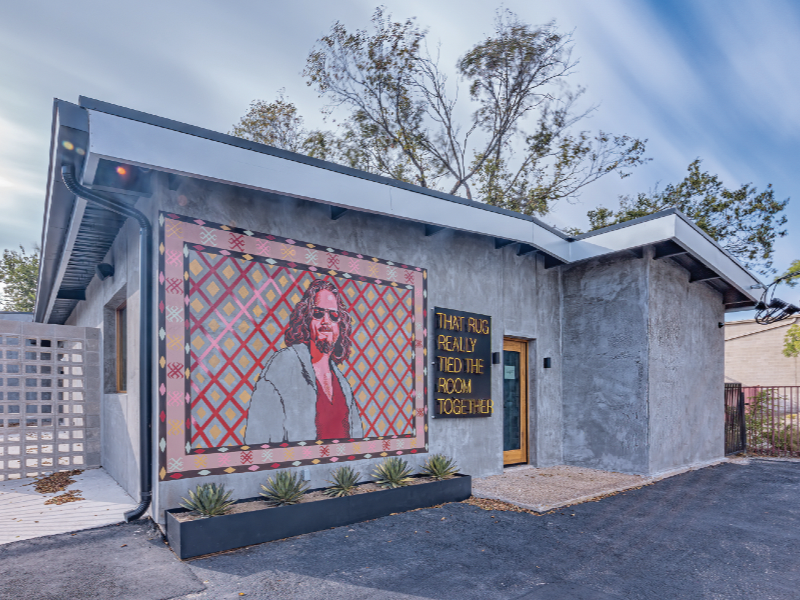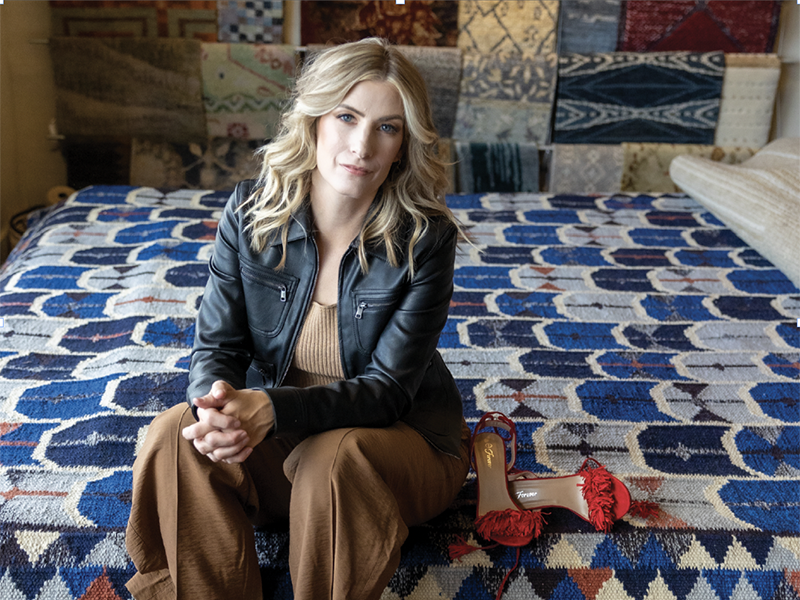Macro world events such as COVID cut across all industries, however the rug profession also presents unique challenges that a trusted colleague may help unravel. Candid conversations spark the mind, and sharing the journey with colleagues strengthens our profession. In the best of circumstances, positive industry relationships enrich our personal lives as well.
It’s in this spirit of sharing that Rug Insider launches a series of dealer interviews between Brian Robins, co-owner with Rebecca Lurie of Kush Rugs, Portland, Oregon and premier showrooms across the country.
We begin with Anna Grace Augusto, the owner of Augusto Fine Rugs in Boise Idaho.
You’re a first-generation dealer and chose to be in this business. How did you get your start?
I grew up in a really small town in Idaho and always wanted to be an interior designer. Right after high school I moved to San Francisco and went to the Academy of Art. I studied interior architecture and then worked for architectural firms, but I’m a social creature and there was something about it I wasn’t connecting to. In my late twenties, I moved back to Boise thinking I would re-evaluate. I needed a job and Macy’s was hiring. They put me in the basement selling rugs and mattresses.
So, it was kismet?
It was, but initially it felt like a huge demotion because I was in the basement in this old department store. I am glad I was able to look past that, because it led to an awesome career.
How did you make the jump in your mind from the basement at Macy’s to, “I want to be an entrepreneur, I want to control my own destiny and be in the rug business.”
I enjoyed working for Macy’s. It gave me a good corporate background. I worked for them for two years and then I managed another rug showroom in Boise for about eight years. I had a lot of autonomy running that business. I did everything but sign the checks.
I grew up in an entrepreneurial family. My dad was a mortician and we always owned our own businesses. I had business ingrained in my spirit.
Over the years, what’s a significant change you’ve experienced?
When I started in the industry, people in general made their buying decisions inside the showroom. It’s inverted now. Before people come into our showroom they already have an idea of what they want. Trying to make your inventory fit what people want isn’t always ideal. I consider myself almost like a rug broker. A client comes in with their wants and needs for a project, and I’m editing through all the available vendors, lead times, and of the factors that will make their project successful and presenting the best fit.
I love your Instagram posts featuring shoes paired with rugs. Your personality really comes through. It looks like you’re having fun!
Thank you. I got the idea from Kathleen Mayers of KPM Flooring. We’re in the fashion business and it’s a great way to integrate fashion with rugs. I’ve always loved clothes and shoes. Last May we did an event with designers and had them bring all of their shoes. We hired a professional photographer and did three hours of shooting “Tuesday Shoesday,” and I let them pick out their favorite rugs. So now I have a whole bank of professional photo content.

Augusto’s “Tuesday Shoesday” photo event integrated fashion with rugs. Images posted to Instagram tagged the clients who shared their fancy footwear and favorite rug combos.
I like how you involved your clients and made the shoot experiential marketing. I assume that when you post “Tuesday Shoesday” and tag clients, they tag you back and it gives you a boost on Instagram.
Yes. Additionally, we’ll tag the shoe brand. We have designers that have some pretty fancy shoes. We’ll usually batch our photography and do a bunch of content. I’ve found with posting that it’s better to sprinkle in professional photography instead of using them all of the time. People enjoy beautiful, well-thought-out photos, but they also enjoy ones that are a bit more scrappy. Fashion and trends are always changing.
What do you do with old samples?
At the end of every year, we gather up old samples and even larger rugs that aren’t selling and I donate them to the Agency for New Americans. It’s a non-profit in Boise that finds housing and resources for refugees. These families are coming over with truly nothing and we like to make them feel like they have just a little bit of home. I’ll donate rugs and samples so that their new environment feels softer and more cozy.
Closing thoughts?
The rug business is a world of great paradoxes. Nothing is cut and dry and I’ve found that it isn’t linear. It’s navigating a day at a time through what this business is and what you want it to look like. My strength over the last year is that I’ve done business my way.
Our dealer discussion continues with Damien Clark, a co-owner of Black Sheep Unique in Austin, Texas.

Erica and Damien Clark (third and fourth from left) pose with family in front of “The Dude” outside of their showroom.
What attracted you to the rug business?
It was a strange route. I was a designer for a furniture company, helping them open stores, and I wanted to find something different. An acquaintance whose wife was the bookkeeper at a high-end rug showroom in downtown Austin said, “You should go down there. They need a new salesperson.”
I went down there and he interviewed and hired me on the spot.
How long did you work for someone else before going out on your own?
It was a little over two years.
Is your current model to the design trade?
Yes, we only sell to the trade.
How do you communicate your showroom policy to the public?
Our approach is to let them know upfront when they come in that we're happy to answer questions, but that we are a wholesaler to the trade.
We explain that we work with designers that would be happy to help them facilitate or make a purchase, and that purchases would have to be done through the design community.
I’m sure your design clients really respect and appreciate the consistency.
100-percent. The design community, regardless of how big of a town or city you’re in, is still so small.
Black Sheep recently bought a building. Congratulations! That’s a huge step up in terms of acquiring a long-term asset outside of the rug business. Is that something that you were angling to do for a while?
Our lease was coming up and we were seeing a lot of pass-through repairs. We kind of knew that everything was going to increase and so we started looking to buy. We bought a building from a guy that had been welding since 1974. He was in his seventies, showed up every morning at seven AM and welded until the day he sold the building. We really just got lucky.

Major renovations were needed to convert this former welding shop into a showroom space. After a year of construction, the Clarks opened Black Sheep’s new home in Austin, TX.
You’re a partner at Black Sheep along with your wife, Erica. How do you both manage the business versus your personal life? How do you leverage the benefits of the partnership and limit the downside?
My wife Erica and I are definitely opposites in a lot of ways, including the business side of things. Our roles are very defined. I’m the head of sales and she’s the backend. She does all of the bookkeeping. She’s very good with the numbers and billing. She’s very good at all of that and also creative.
Erica does a lot of our rug designing, a lot of our coloration. She’s great at art. I can see something and say that's good, or that’s not good. I can also see something and say, I can sell that, or I can’t, but it's harder for me to create something from scratch.
Funny enough, Erica’s brother Cody runs our showroom.
It’s a real family affair.
Yeah, he’s our GM. Turning it off is the hardest part. Sometimes we just can't. You get home, you have dinner, you go on a walk and talk, and it’s usually about the business. It’s such a huge part of our lives that outside of talking about our kids, it's probably the main thing we talk about.
How old are your kids?
23 and 21. There's a lot of multi-generational family ownership in our industry, which has pluses and minuses.
How does your family feel about it?
We’ve never really brought it up directly to our kids. It’s something that we obviously recognize in the rug business.
We set up a secondary business called “Lynn Mettee,” which is our design business where we’re designing rugs and selling custom. I feel like if they wanted to come into the business, we’re trying to set up an avenue for it.
What are some of the biggest changes that you’ve noticed during your time in the rug business?
The biggest change is custom. We used to do one, maybe two custom rugs a year. Everything was sold out of the stacks. You sold the inventory that you had. Whereas now, that’s completely flipped on its head.
Through COVID, when the rugs were actually coming quicker than the furniture, it just changed everything. Clients that wouldn't wait before, now they’re just fine with custom rug lead times. It’s the new norm.
Are there any observations that you’d like to share with the rug community?
In closing, I’d say that I’m excited about the rug business. It’s stood the test of time and I’m excited about its future. I think it's changing and we have to change with it.
Images courtesy of their respective companies.



